2003 Oldsmobile Alero change wheel
[x] Cancel search: change wheelPage 188 of 354

Of course, traction is reduced when water, snow, ice, Driving at Night
gravel or other material is on the road. For safety, you’ll
want to slow down and adjust your driving to these
conditions. It is important to slow down on slippery
surfaces because stopping distance will be longer and
vehicle control more limited.
While driving on a surface with reduced traction, try
your best to avoid sudden steering, acceleration
or braking (including engine braking by shifting to a
lower gear). Any sudden changes could cause the tires
to slide. You may not realize the surface is slippery
until your vehicle is skidding. Learn to recognize warning
clues
- such as enough water, ice or packed snow
on the road to make a “mirrored surface”
- and slow
down when you have any doubt.
If you have the anti-lock braking system, remember: It
helps avoid only the braking skid.
If you do not have
anti-lock, then in a braking skid (where the wheels are
no longer rolling), release enough pressure on the
.A
brakes to get the wheels rolling again. This restores
steering control. Push the brake pedal down steadily Night driving is more dangerous than day driving.
are rolling, you will have steering control. impaired
- by alcohol or drugs, with night vision
... Le- ..-.. Le..- A- -Le- -..AA--l.. A- I--- ^^ IL- ... L--l- VVI IGfI YUU I IaVG LU
31Up 3UUUGI Ily. fi3 IUI IY 63 11 It; VVI lGGl3 An,-, rnmpnn ia- thrrt a-nmn AriItnrp -srn l;i,nlt, tn hn VI Ib IbU.2WI I 1.2 LI IUC .2VIII~ UIIVbl.2 UlCI III\bIy cv Ub
problems, or by fatigue.
4-1 5
Page 209 of 354

Towing a Trailer
If you don’t use the correct equ,pment and
drive properly, you can lose control when you
pull a trailer. For example, if the trailer is too
heavy, the brakes may not work well
-- or even
at all.
You and your passengers could be
seriously injured. You may also damage your
vehicle; the resulting repairs would not be
covered by your warranty. Pull a trailer only
if
you have followed all the steps in this section.
Ask your dealer for advice and information
about towing a trailer with your vehicle. Your
vehicle can tow a trailer
if it is equipped with the
proper trailer towing equipment. To identify what
the vehicle trailering capacity is for your vehicle, you
should read the information in “Weight of the Trailer” that
appears later in this section. But trailering is different
than just driving your vehicle by itself. Trailering means
changes in handling, durability and fuel economy.
Successful, safe trailering takes correct equipment, and
it has to be used properly.
That’s the reason for this part. In it are many time-tested,
important trailering tips and safety rules. Many of
these are important for your safety and that of your
passengers.
So please read this section carefully before
you pull a trailer.
Load-pulling components such as the engine, transaxle,
wheel assemblies and tires are forced to work harder
against the drag of the added weight. The engine
is required to operate at relatively higher speeds and
under greater loads, generating extra heat. What’s more,
the trailer adds considerably to wind resistance,
increasing the pulling requirements.
4-36
Page 214 of 354
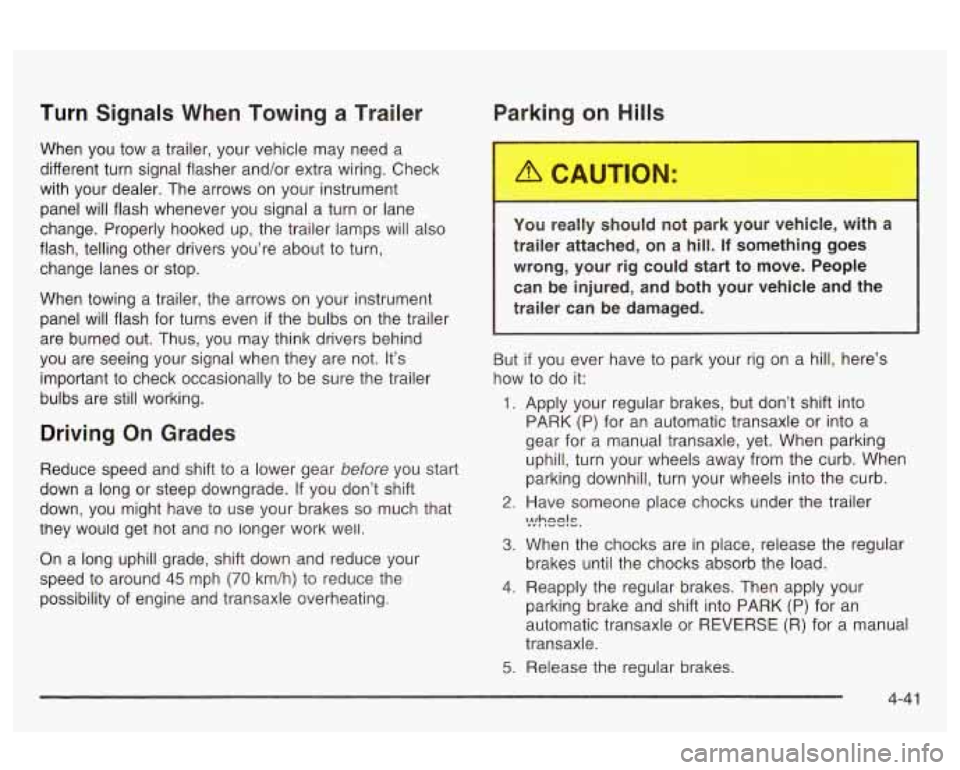
Turn Signals When Towing a Trailer
When you tow a trailer, your vehicle may need a
different turn signal flasher and/or extra wiring. Check
with your dealer. The arrows on your instrument
panel will flash whenever you signal a turn or lane
change. Properly hooked up, the trailer lamps will also
flash, telling other drivers you’re about to turn,
change lanes or stop.
When towing a trailer, the arrows on your instrument
panel will flash for turns even
if the bulbs on the trailer
are burned out. Thus, you may think drivers behind
you are seeing your signal when they are not. It’s
important to check occasionally to be sure the trailer
bulbs are stiil working.
Driving On Grades
Reduce speed and shift to a lower gear before you start
down a long or steep downgrade. If you don’t shift
down, you might have to use your brakes
so much that
they would get hot and no longer work well.
On a long uphill grade, shift down and reduce your
speed to around
45 mph (70 km/h) to reduce the
possibility of engine and transaxle overheating.
P; ‘ting on Hills
You really should not park your vehicle, with a
trailer attached, on a hill.
If something goes
wrong, your rig could start to move. People
can be injured, and both your vehicle and the
trailer can be damaged.
But
if you ever have to park your rig on a hill, here’s
how to do it:
1. Apply your regular brakes, but don’t shift into
PARK (P) for an automatic transaxle or into a
gear for a manual transaxle, yet. When parking
uphill, turn your wheels away from the curb. When
parking downhill, turn your wheels into the curb.
2. Have someone place chocks under the trailer
1/:!?ee!s.
3. When the chocks are in place, release the regular
brakes until the chocks absorb the load.
4. Reapply the regular brakes. Then apply your
parking brake and shift into PARK (P) for an
automatic transaxle or
REVERSE (R) for a manual
transaxle.
5. Release the regular brakes.
4-4 1
Page 270 of 354
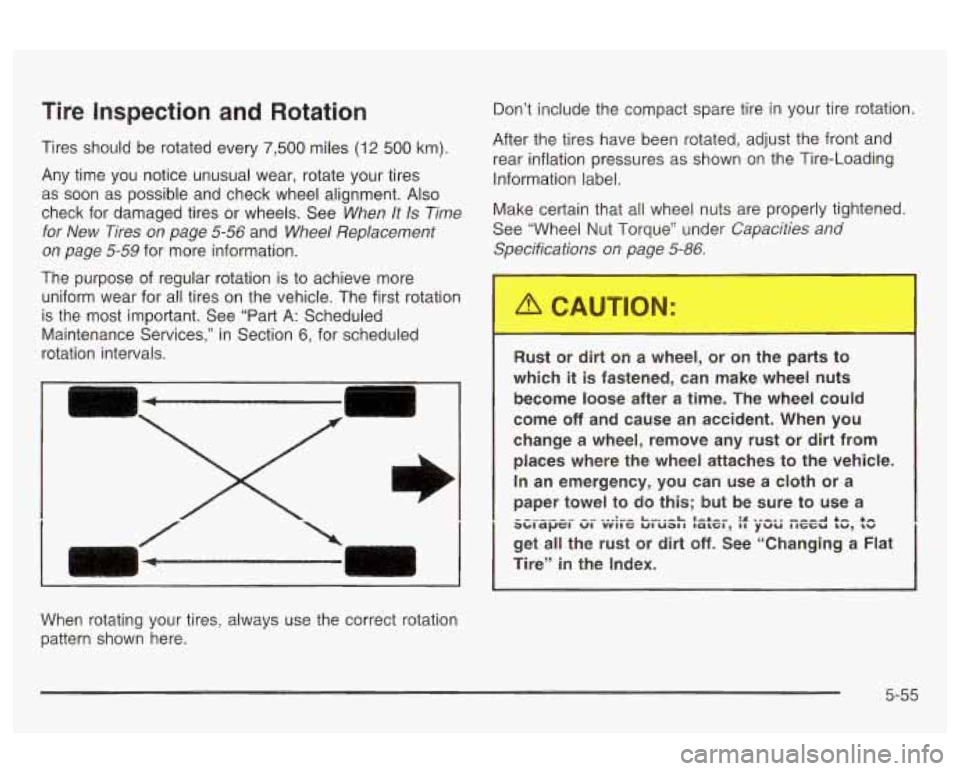
Tire Inspection and Rotation
Tires should be rotated every 7,500 miles (12 500 km).
Any time you notice unusual wear, rotate your tires
as soon as possible and check wheel alignment. Also
check for damaged tires or wheels. See
When It Is Time
for New Tires on page
5-56 and Wheel Replacement
on page
5-59 for more information.
The purpose of regular rotation is to achieve more
uniform wear for all tires on the vehicle. The first rotation
is the most important. See “Part A: Scheduled
Maintenance Services,” in Section 6, for scheduled
rotation intervals. Don’t include the
compact spare tire in your tire rotation.
After the tires have been rotated, adjust the front and
rear inflation pressures as shown
on the Tire-Loading
Information label.
Make certain that all wheel nuts are properly tightened.
See “Wheel Nut Torque” under
Capacities and
Specifications on page
5-86.
Rust or dirt on a wheel, or or parts to
which
it is fastened, can make wheel nuts
become loose after a time. The wheel could
come
off and cause an accident. When you
change a wheel, remove any rust
or dirt from
places where the wheel attaches to the vehicle.
In an emergency, you can use a cloth or a
paper towel to do
this; but be sure to use a
3cllCapcI VI VVll c; ut U3If IBLGI, II ywu IIG‘CSU LW, LW
get all the rust or dirt off. See “Changing a Flat
Tire”
in the Index.
--_ .------ -_. ... :-- L”..-L I-*-” :+ .--. ~ “...-A 4- 4-
When rotating your tires, always use the correct rotation
pattern shown here.
5-55
Page 277 of 354
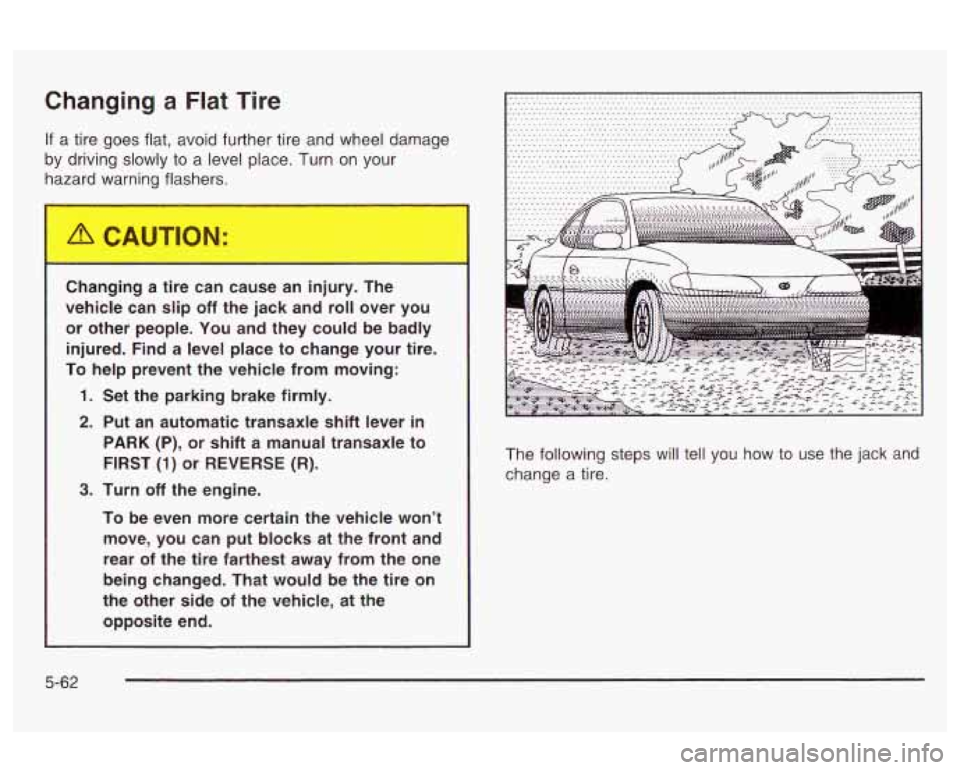
Changing a Flat Tire
If a tire goes flat, avoid further tire and wheel damage
by driving slowly to a level place. Turn on your
hazard warning flashers.
Changing a tire can cause an injury. The
vehicle can slip
off the jack and roll over you
or other people. You and they could be badly
injured. Find a level place to change your tire.
To help prevent the vehicle from moving:
1. Set the parking brake firmly.
2. Put an automatic transaxle shift lever in
PARK (P), or shift a manual transaxle to
FIRST
(1) or REVERSE (R).
3. Turn off the engine.
To be even more certain the vehicle won't
move, you can put blocks at the front and
rear
of the tire farthest away from the one
being changed. That would be the tire on
the other side
of the vehicle, at the
opposite end. The following
steps will tell you how to use the jack and
change a tire.
5-62
Page 282 of 354
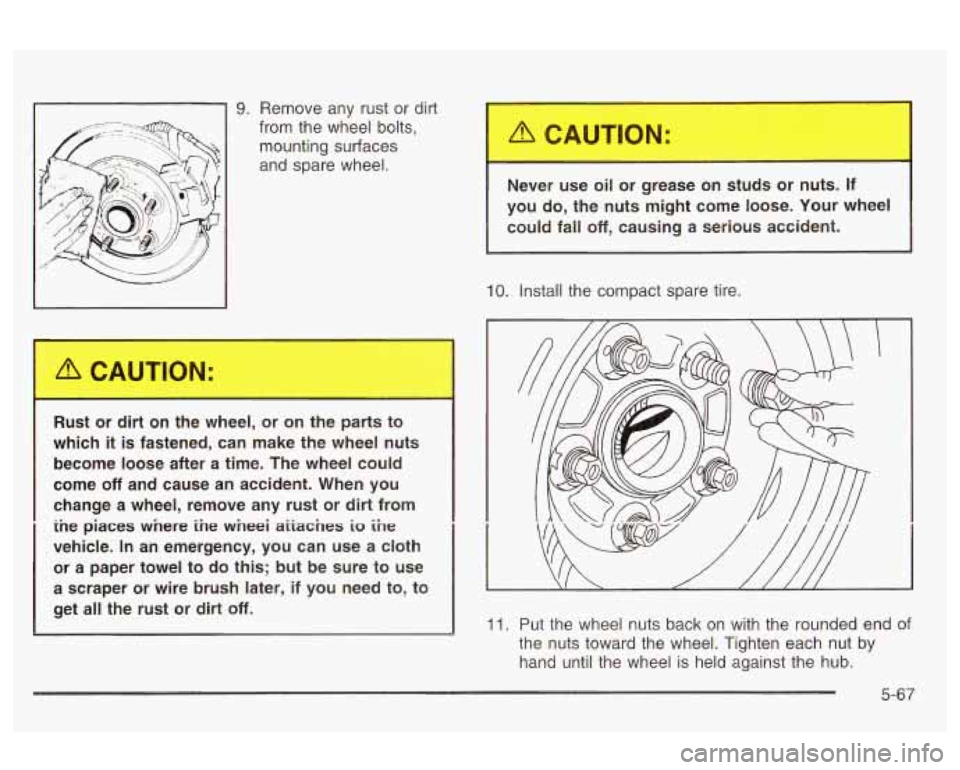
9. Remove any rust or dirt
from the wheel bolts,
mounting surfaces
and spare wheel.
R---t OL Art on the wheel, or on the parts to
which
it is fastened, can make the wheel nuts
become loose after a time. The wheel could
come
off and cause an accident. When you
change a wheel, remove any rust or dirt from
ine piaces wnere ine wneei aiiaches io ihe
vehicle. In an emergency, you can use a cloth
or a paper towel to do
this; but be sure to use
a scraper or wire brush later, if you need to, to
get all the rust or dirt
off.
Never use c or grease on studs or nl If
you do, the nuts might come loose. Your wheel
could fall
off, causing a serious accident.
10. Install the compact spare tire.
11. Put the wheel nuts back on with the rounded end of
the nuts toward the wheel. Tighten each nut by
hand until the wheel is held against the hub.
5-67
Page 346 of 354
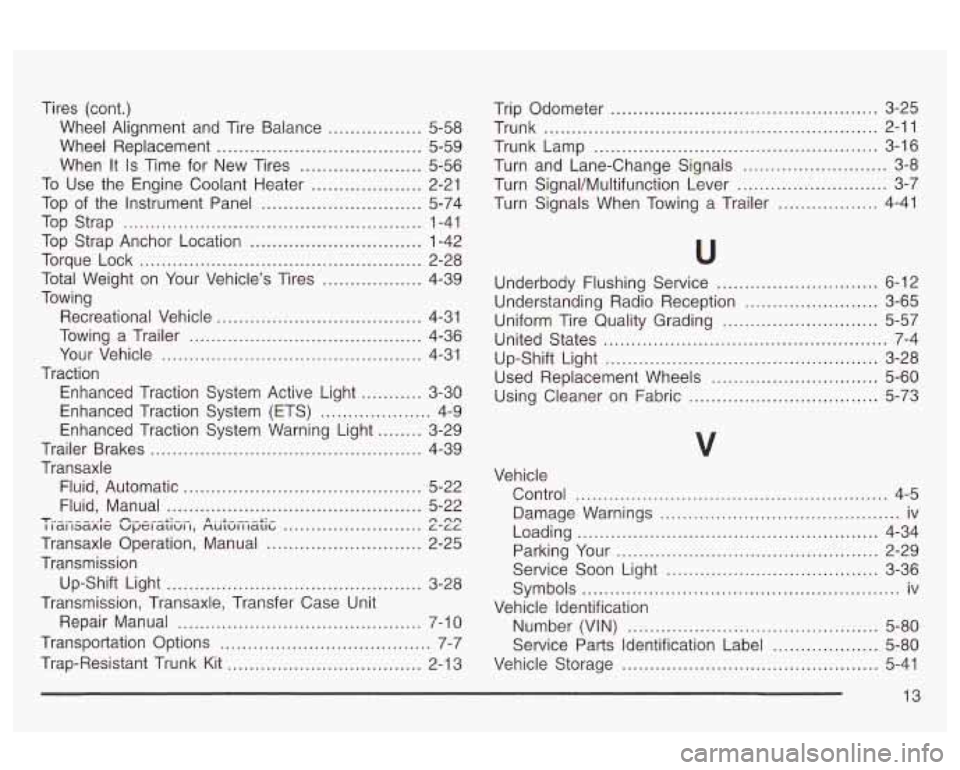
Tires (cont.) Wheel Alignment and Tire Balance
................. 5-58
Wheel Replacement
..................................... 5-59
When It
Is Time for New Tires ...................... 5-56
To Use the Engine Coolant Heater
.................... 2-21
Top of the Instrument Panel
............................. 5-74
Top Strap
...................................................... 1-41
Top Strap Anchor Location
............................... 1-42
Torque Lock
................................................... 2-28
Total Weight on Your Vehicle’s Tires
.................. 4-39
Towing Recreational Vehicle
..................................... 4-31
Towing a Trailer
.......................................... 4-36
Your Vehicle
............................................... 4-31
Traction Enhmced Traction Systerr; Active Light
........... 3-30
Enhanced Traction System Warning Light
........ 3-29
Enhanced
Traction System (ETS)
.................... 4-9
Trailer Brakes
................................................. 4-39
Transaxle Fluid, Automatic
........................................... 5-22
Fluid, Manual
.............................................. 5-22 T - - .. I - n- -.--a: - .- A . .I -.-- -L:- I I dl 13dAlt: Upel dllUl I, fiUlUl1 ldllb 6-66 A nA .........................
Transaxle Operation, Manual ............................ 2-25
Transmission Up-Shift Light
.............................................. 3-28
Transmission, Transaxle, Transfer Case Unit
Repair Manual
........................................ 7-10
Transportation Options
...................................... 7-7
Trap-Resistant Trunk Kit
................................... 2-1 3 Trip Odometer
.......... ........................... 3-25
Trunk
............................................................ 2-11
Turn and Lane-Change Signals
.......................... 3-8
Turn Signal/Multifunction Lever
........................... 3-7
Turn Signals When Towing a Trailer
.................. 4-41
Trunk Lamp
................................................... 3-16
Underbody Flushing Service
............................. 6-12
Understanding Radio Reception
........................ 3-65
Uniform Tire Quality Grading
............................ 5-57
United States
................................................... 7-4
Up-Shift Light
................................................. 3-28
Used Replacement Wheels
.............................. 5-60
using Cleaner on Fabric
.................................. 5-73
v
Vehicle
Control
........................... ..................... 4-5
Damage Warnings
........................................... iv
Loading
...................................................... 4-34
Service Soon Light
...................................... 3-36
Parking
Your
............................................... 2-29
Symbols
......................................................... iv
Vehicle Identification
Number (VIN)
............................................. 5-80
Service Parts Identification Label
................... 5-80
Vehicle Storage
.............................................. 5-41
13
Page 347 of 354

Ventilation Adjustment ...................................... 3-22
Vinyl
............................................................. 5-74
Visor Vanity Mirror
.......................................... 2-15
Visors
........................................................... 2-1 5
Warning Lights. Gages and indicators ................ 3-23
Warnings
Hazard Warning Flashers
............................... 3-6
Other Warning Devices
.................................. 3-6
Safety and Symbols
......................................... iii
Vehicle Damage .............................................. iv
Washer Fluid, Low Warning Light
...................... 3-36
Washing Your Vehicle
...................................... 5-75
Weatherstrip Lubrication
................................... 6-1 0
Weight of the Trailer ........................................ 4-37
Weight
of the Trailer Tongue ............................. 4-38
What Kind
of Engine Oil to Use ........................ 5-18
What to Do with Used Oil
................................ 5-20
What to Use
.......................................... 5-24, 5-36
Wheels Alignment and Tire Balance
.......................... 5-58
Replacement
............................................... 5-59
When to Add Engine Oil
.................................. 5-17
When to Change Engine Oil
(GM Oil Life SystemTM)
................................ 5-19
When to Check
.............................................. 5-54
When to Check and What to Use
..................... 5-23 When
to Check Power Steering Fluid
................ 5-35
When You Are Ready to Leave After Parking
on a Hill
..................................................... 4-42
Where to Put the Restraint
........... ............ 1-41
Window Lockout
............................................. 2-15
Windows
....................................................... 2-14
Manual
...................................................... 2-14
Power
........................................................ 2-15
Windshield and Wiper Blades
....................... 5-76
Windshield Washer
..................................... 3-10
Fluid
.......................................................... 5-36
Windshield Washer Fluid Level Check
................. 6-9
Windshield Wiper
Blade Replacement
...................................... 5-52
Fuses
........................................................ 5-81
Windshield Wipers
............................................ 3-9
Winter Driving
......... ................................ 4-25
Wiper Blade Check
..... ........ ........ 6-10
Why Safety Belts Work
.................................... 1-10
X
XMTM Satellite
Radio Antenna System ................ 3-67
XMTM Satellite Radio Service
............................ 3-65
Your Vehicle and the Environment
....................... 6-2
14